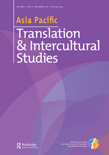
Asia Pacific Translation and Intercultural Studies
Scope & Guideline
Championing interdisciplinary scholarship in translation and intercultural studies.
Introduction
Aims and Scopes
- Intercultural Communication and Translation:
The journal emphasizes the role of translation as a medium for intercultural communication, examining how translations facilitate cultural exchange and understanding across diverse linguistic and cultural landscapes. - Translation Methodologies and Theories:
It promotes a variety of methodologies in translation studies, encouraging researchers to explore both traditional and contemporary theories of translation, including cognitive, sociological, and historical perspectives. - Literary Translation and Cultural Adaptation:
The journal showcases research on literary translation, focusing on how literary works are adapted across cultures, and the implications of these adaptations for both source and target cultures. - Translation and Technology:
It addresses the impact of technology on translation practices, exploring how digital tools and platforms influence translation processes, accessibility, and reception in contemporary society. - Translation Criticism and Ethics:
The journal fosters discussions on translation criticism, ethics, and the responsibilities of translators, particularly in politically sensitive or culturally charged contexts.
Trending and Emerging
- Feminist and Gender Perspectives in Translation:
There is an increasing focus on feminist translation and gender studies, exploring how translation practices intersect with issues of gender, power, and representation in various cultural contexts. - Interdisciplinary Approaches to Translation Studies:
Recent publications highlight the integration of various disciplines within translation studies, such as cognitive science, media studies, and cultural studies, indicating a trend towards more holistic research methodologies. - Impact of Technology on Translation:
The influence of technology on translation practices is gaining traction, with studies examining the role of digital tools, machine translation, and their implications for translators and the translation industry. - Translational Activism and Ethics:
Research on the ethical implications of translation and the role of translators as activists is emerging, reflecting a growing concern for social justice and the responsibilities of translators in politically sensitive contexts. - Transcultural Studies and Adaptation:
There is a notable trend towards exploring transcultural studies and the adaptation of literary works across cultures, emphasizing how translations shape and are shaped by cultural interactions.
Declining or Waning
- Historical Translation Studies:
There has been a noticeable decrease in papers focusing strictly on historical aspects of translation, indicating a shift towards contemporary practices and theories over historical analysis. - Translation of Non-Literary Texts:
The focus on the translation of non-literary texts, such as technical or scientific documents, appears to be waning, as the journal increasingly prioritizes literary and cultural translations. - Traditional Approaches to Translation Theory:
Conventional theories of translation that do not incorporate interdisciplinary approaches or modern technological influences are becoming less common, as the field moves towards more dynamic and integrated methodologies. - Focus on Regional Translation Practices:
There is a decline in research specifically centered on translation practices within certain localized or regional contexts, suggesting a broader, more global perspective in recent publications.
Similar Journals

Skandinavskaya Filologiya
Unveiling the Rich Tapestry of Scandinavian Heritage.Skandinavskaya Filologiya is a distinguished academic journal published by St Petersburg University Press that specializes in Scandinavian philology and linguistics. With its ISSN 0202-2397 and E-ISSN 2618-9518, this journal serves as a vital platform for scholarly articles that explore the intricate languages, literature, and cultural nuances of the Scandinavian region. The journal seeks to promote interdisciplinary research and foster collaboration among linguists, literary scholars, and cultural researchers interested in the rich heritage and contemporary developments within Scandinavian studies. Although the journal operates without open access, it is committed to enhancing academic discourse and providing a valuable resource for students, professionals, and researchers. Located in the vibrant city of St Petersburg, Russia, the journal aims to bridge the gap between Eastern and Western scholarship in Scandinavian philology, making it a significant contributor to the field.
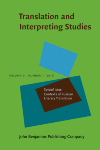
Translation and Interpreting Studies
Illuminating the Pathways of Translation and Interpreting Research.Translation and Interpreting Studies is a prestigious academic journal published by John Benjamins Publishing Co, focused on the dynamic fields of translation and interpreting. Established in 2011, this journal has rapidly ascended to become a leading platform in its domain, achieving Q1 quartile status in Linguistics, Language, and Literature categories as of 2023. With an impressive ranking of #16 out of 1106 in Arts and Humanities for Literature and Literary Theory, and #182 out of 1088 in Language and Linguistics, it is recognized for its significant contributions to scholarly discourse. Although not fully open-access, the journal provides essential insights and research findings for linguists, translators, interpreters, and students, fostering a greater understanding of the theoretical and practical implications of translation studies. Situated in the Netherlands, it plays a vital role in the global academic community, bridging gaps between theory and practice, and ensuring that cutting-edge research is readily accessible to professionals and scholars alike.
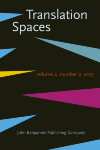
Translation Spaces
Connecting Theory and Practice in Translation StudiesTranslation Spaces is a premier academic journal dedicated to the interdisciplinary study of translation and its implications across various fields, including communication, linguistics, and literature. Published by John Benjamins Publishing Company, this journal is based in the Netherlands and boasts an impressive impact factor, reflecting its significance in the scholarly landscape, particularly within Q1 quartiles for Communication, Linguistics and Language, and Literature and Literary Theory as of 2023. Recognized for its commitment to advancing knowledge, Translation Spaces provides an essential platform for researchers, educators, and practitioners to explore innovative theoretical perspectives and empirical findings. With a comprehensive scope that spans from 2016 to 2024, the journal is indexed in Scopus, securing high ranks in both Arts and Humanities and Social Sciences, offering a 99th percentile rank in Literature and Literary Theory and maintaining a strong presence in Linguistics and Language. The absence of open access options ensures that the quality and integrity of published research are upheld, making it a valuable resource for the academic community engaged in translation studies.
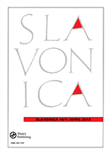
SLAVONICA
Illuminating Slavic Heritage Through Interdisciplinary InquirySLAVONICA is a distinguished academic journal dedicated to the exploration and analysis of Slavic studies, incorporating a wide array of cultural, historical, and linguistic perspectives. Published by Routledge Journals, Taylor & Francis Ltd, this journal serves as a critical platform for interdisciplinary scholarship, emphasizing the dynamic nature of Slavic cultures and languages. Though it currently does not offer Open Access, SLAVONICA is an important resource for researchers, professionals, and students seeking to engage with the latest academic discourse in the fields of Cultural Studies, History, Literature, and Linguistics, achieving a recognized place in the Q4 quartile across several categories as of 2023. With coverage spanning from 1994 to 2024, and its commitment to fostering academic inquiry, SLAVONICA plays a vital role in elevating the understanding of Slavic heritage and contemporary issues, making it essential reading for anyone interested in the complexities of this region.

Translation & Interpreting-The International Journal of Translation and Interpreting
Pioneering Open Access Scholarship in Translation and InterpretingTranslation & Interpreting is the premier Open Access journal dedicated to the intricate fields of translation and interpreting, published by the University of Western Sydney's Interpreting & Translation Research Group. With an established reputation since its inception in 2009, this journal has quickly ascended to become a vital resource, recognized in the 2023 Q1 quartile rankings for both Linguistics and Language as well as Literature and Literary Theory. Its high standing is further supported by impressive Scopus rankings, placing it among the top journals in its field—#21 out of 1106 in Literature and Literary Theory and #204 out of 1088 in Language and Linguistics. With a commitment to disseminating original research and innovative practices, Translation & Interpreting serves as a crucial platform for scholars, practitioners, and students who aspire to deepen their understanding of translation dynamics and interpretation methodologies. Based in Australia, the journal actively contributes to global discourse by making research freely accessible, upholding the values of transparency and inclusivity in the academic community. Embark on your exploration of this influential journal that shapes the landscape of translation and interpreting research.
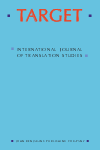
Target-International Journal of Translation Studies
Transforming Translation Theory into PracticeTarget - International Journal of Translation Studies, published by John Benjamins Publishing Co, stands as a leading academic forum in the fields of translation studies, communication, and linguistics. Established in 1989, this prestigious journal has successfully evolved, boasting a Q1 classification in 2023 within both Communication and Linguistics and Language categories, reflecting its significant impact and influence in these disciplines. With an impressive positioning in the Scopus ranks, it is recognized as one of the top journals in its field, being placed in the 88th percentile for Language and Linguistics, and in the 87th percentile for Linguistics and Language within the Social Sciences. Its rigorous scholarly contributions foster a greater understanding of translation practices, theories, and methodologies, making it an essential resource for researchers, professionals, and students alike. While it does not currently offer open access, its comprehensive articles and studies greatly enrich discussions and advancements in translation and communication studies.
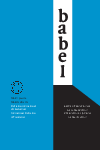
Babel-Revue Internationale de la Traduction-International Journal of Translation
Elevating Translation Studies to New HeightsBabel - Revue Internationale de la Traduction - International Journal of Translation, published by John Benjamins Publishing Co, is a leading scholarly journal that has established itself as a critical platform for research in the fields of translation studies, linguistics, and communication. Since its inception in 1955, Babel has provided a forum for academic discourse and has adapted through converged years to continuously reflect the evolving landscape of translation theory and practice. The journal is recognized for its high impact, achieving a Q1 ranking in Linguistics and Language and Q2 in Communication, making it relevant for both researchers and practitioners seeking to contribute to this dynamic area of study. With significant Scopus rankings in various categories, Babel is instrumental in promoting innovative research and fostering multidisciplinary dialogue. Although it does not offer open access, the journal is accessible through numerous academic institutions worldwide, ensuring that vital insights into translation practices and theories are disseminated effectively. Researchers, professionals, and students alike will find a wealth of knowledge and groundbreaking perspectives within its pages, making Babel an essential resource in the field.
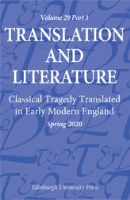
Translation and Literature
Fostering Dialogue Across Literary LandscapesTranslation and Literature is a leading academic journal published by Edinburgh University Press, focusing on the intricate relationship between language and literature within the realms of translation studies. With an ISSN of 0968-1361 and an E-ISSN of 1750-0214, this journal provides a crucial platform for scholars and practitioners to explore and disseminate research that addresses both the theoretical and practical aspects of translation. Since its inception in 1996, Translation and Literature has established itself as an essential resource, particularly noted for its contributions to the fields of linguistics and literary theory, as indicated by its Q4 ranking in both categories in 2023. The journal's articles are designed to foster dialogue across disciplines, encouraging innovative thinking and collaboration among researchers, professionals, and students alike. Access to this valuable resource is currently available through subscription, ensuring high-quality scholarship reaches a diverse audience dedicated to advancing the understanding of translation's role in literature.

MonTI
Fostering Scholarly Dialogue in Linguistics and EducationMonTI (ISSN: 1889-4178; E-ISSN: 1989-9335), published by UNIV JAUME I, stands as a pivotal journal in the domains of Education, Linguistics, and Language, based in Castellón de la Plana, Spain. With a notable impact factor reflected in its 2023 Scopus rankings—sitting in the Q1 quartile for Linguistics and Language—this journal is dedicated to advancing knowledge and research in these fields from 2014 to 2024. MonTI provides a platform for scholars and practitioners to disseminate innovative ideas and practices, ensuring open access for those interested in the intersection of language and education. Its robust ranking in arts and humanities and social sciences not only underscores its academic prestige but also emphasizes its relevance in fostering scholarly dialogue. Whether you are a researcher, educator, or student, MonTI offers rich resources and insights to enhance your understanding and practice in linguistics and education.
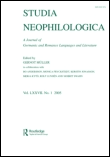
STUDIA NEOPHILOLOGICA
Connecting Language, Philosophy, and ScholarshipSTUDIA NEOPHILOLOGICA, published by Routledge Journals, Taylor & Francis Ltd, is a distinguished periodic publication that has been contributing to the fields of Linguistics and Philosophy since its inception in 1928. With an ISSN of 0039-3274 and E-ISSN 1651-2308, this journal is recognized within the academic community as an essential platform for innovative research and scholarship. It currently holds a Q3 quartile ranking in both Linguistics and Philosophy categories for 2023, further illustrating its relevance in a competitive landscape, where it ranks #465 out of 1088 in Scopus Ranks for Language and Linguistics. Although not openly accessible, the journal provides vital insights and analyses that push the boundaries of understanding language and its philosophical implications. With a coverage spanning from 1928 to 2024, STUDIA NEOPHILOLOGICA is indispensable for researchers, professionals, and students eager to expand their knowledge and engage with critical discussions in these disciplines.